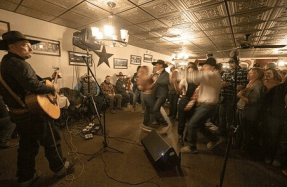The battle for the Black Hills

FROM A DISTANCE, the green pines and the blue-gray haze that gently hug the valleys of the Black Hills merge into a deep black. The Lakota name “He Sapa” — meaning “black ridge” — describes this visual phenomenon. This is a place of origin for dozens of Native peoples and a revered landscape for more than 50 others. The land’s most recent, and perhaps longest-serving, stewards — the Oceti Sakowin, the Dakota, Nakota and Lakota people — hold the mountains central to their cosmos.
The Black Hills are also central to the political territory drawn by the 1851 and 1868 Fort Laramie treaties. And they continue to be a crucial part of the strategic position that sustained Native resistance to white encroachment. They have become an international symbol of the call to return stolen land to Indigenous people. That’s why President Donald Trump chose to hold his July 3 rally at Mount Rushmore, said Nick Tilsen, who is Oglala Lakota. The faces of U.S. Presidents George Washington, Thomas Jefferson, Theodore Roosevelt and Abraham Lincoln are carved into the side of the granite mountain that is the heart of the Lakota universe.
Tilsen is the president and CEO of NDN Collective, a Native-run nonprofit based in Rapid City, South Dakota, which launched a campaign on Indigenous Peoples’ Day in 2020 to return He Sapa to Native people. Many Lakota people, like Tilsen, view the national monument, which attracts 2 million visitors a year, as a desecration of a spiritual landscape. “What South Dakota and the National Park Service call ‘a shrine to democracy’ is actually an international symbol of white supremacy,” Tilsen said. He was among 20 arrested for protesting Trump’s visit. If convicted, he faces up to 16½ years in prison for four felonies and three misdemeanors.
According to Tilsen, the protesters had negotiated the blockade with the Pennington County Sheriff’s Office and the South Dakota Highway Patrol. The activists
You’re reading a preview, subscribe to read more.
Start your free 30 days





